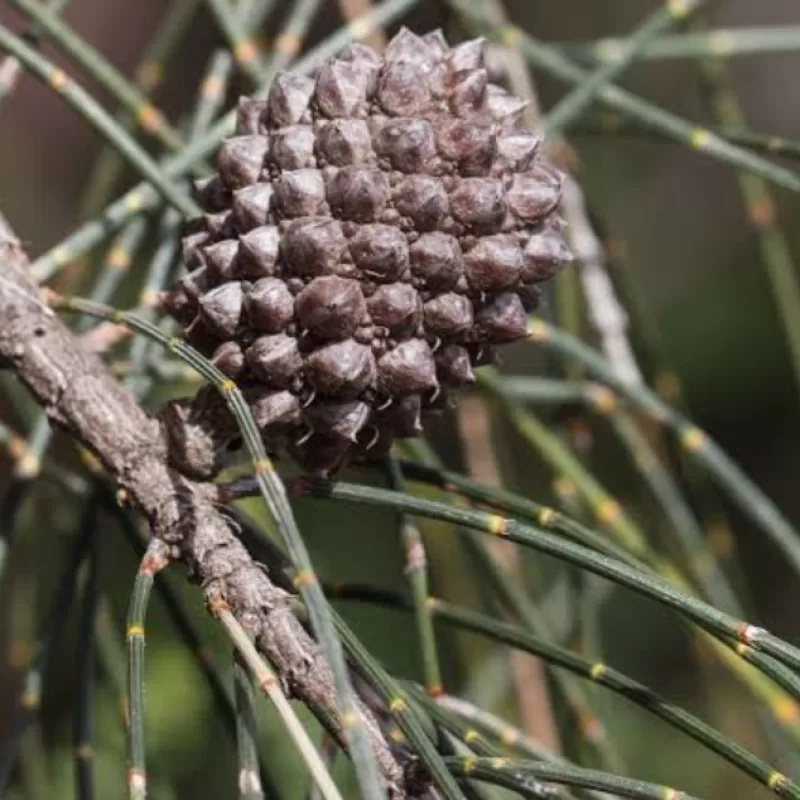Drooping Sheoak

Scientific Name
Allocasuarina verticillata
Family Name
CASUARINACEAE
Common Name
Drooping Sheoak
General Information
| Height | 4.0m - 7.0m (400-700cm) |
| Flowers | Stamens only in spikes up to 12cm long. Male flower spikes yellow-brown and red female flowers. |
| Fruit | Nuts |
| Form | Small much-branched tree |
| Municipalities | Break O'Day; Brighton; Burnie; Central Highlands; Clarence; Derwent Valley; Devonport; Dorset; Flinders Island; Georgetown; Glamorgan-Spring Bay; Glenorchy; Hobart; Huon Valley; Kentish; Kingborough; Latrobe; Launceston; Northern Midlands; Sorell; Southern Midlands; Tasman; West Coast; West Tamar |
| Communities | Coastal Vegetation |
| Habitat Notes | Forms close to pure stands along the margins of coastal cliffs and on dry, rocky, north-facing slopes, especially on dolerite.Also grows inland on dry rocky sites. Probably the most drought-resistant tree species in Tas. Only moderately tolerant of fire.Widespread and frequent especially in eastern Tasmania. |
| Site Tolerance | Dry; Exposed; Moist; Rocky; Windy |
| Frost Tolerance | Hardy |
| Soil Tolerance | Fertile; Loam; Poor; Sandy; Well-drained |
| General Notes | Not prone to insect attack. Trees produce large root nodules that provide habitat for micro-organisms that 'fix' nitrogen. A long-lived species (50-100 years), moderately slow-growing.Plants are highly palatable to livestock and rabbits and usually require protection to establish.Good for medium level windbreaks, useful for erosion control due to its ability to shoot from the roots and the leaf litter stabilisesoil surface.Has potential for management under a coppice regime for firewood production. Provides food for seed-eating birds and is important for insect-eating birds. Koori (mainland) uses: Young shoots and cones were occasionally eaten, but the main importance of the sheoke was the use of its wood for making boomerangs and other implements.Resistant to Phytophthora cinnamomi. Not suitable below powerlines. |
Propagation Details
| Flowering Months |
|
||||||||||||
| Seed Collecting Months |
|
||||||||||||
| Sowing Months |
|
||||||||||||
| Cutting Months |
|
Seed Information
| Seed Collection | Winged nuts in cones.cones prickly |
| Seed Treatment Method | Standard |
| Seed Storage Life | 5-10 years |
| Viable Seeds Per Gram | 119 |
| Seed Treatment Notes | Cover with 2mm of potting mix and firm gently. Gravel layer 2 grains.Seed loses viability quickly once released from cone. The seed should be stored at 3-5oC to maintain long term viability. Innoculate with local soil. |
| Germination Time | 10-45 days |
| Suitable For Direct Seeding | Yes |
Cuttings
| Propagation By Division | Yes |
| Cutting Notes | Root suckers can be transplanted during winter when the soil is moist. Difficult to strike from cuttings and strike rate very low. Can be grown from cuttings of semi-hard wood. Coppice shoots taken from cut stumps or damaged plants will strike readily. |

